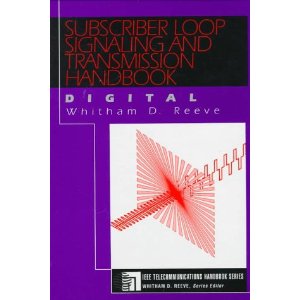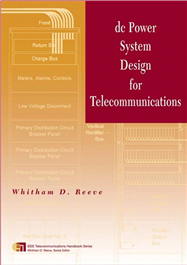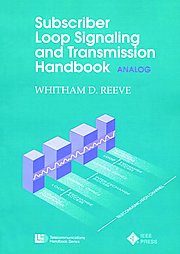Telecommunications Publications & Documents
Books: To order please go to the Bookstore or click on the book cover image
dc Power System Design for Telecommunications, Whitham D. Reeve (2007)
From the back cover: dc Power System Design for Telecommunications is a must-have resource for anyone responsible for designing, installing and maintaining telecommunications systems or systems that require very high reliability. The text explains how to design direct current (dc) power systems that operate at nominal voltages of 48 and 24 volts dc, use lead-acid batteries, and are installed in telecommunications systems and other exclusive use environments. Readers acquire the skills and knowledge to perform systematic analyses to make the best choices based on several economic, operational, electrical and physical considerations.
Written in a straightforward style that avoids unnecessary jargon and complex mathematics, the text covers:
- Detailed descriptions of the seven major system components: Rectifier/charger system, Battery system, Charge bus, Discharge bus, Primary distribution system, Secondary distribution system, and Voltage conversion system
- Detailed descriptions, design equations, reference tables, block diagrams and schematics
- Design procedures to select the most appropriate power system elements, such as buses, wiring, overcurrent protection, rectifiers, and batteries
- Application of American National Standards Institute's telecommunications industry standards and other relevant standards, practices and codes
- Strategies for dealing with voltage drop in distribution and battery circuits as well as guidance for sizing circuit wiring to meet voltage drop and current rating requirements
- In-depth discussions that focus on the types of lead-acid batteries used in telecommunications and their applications
Throughout the text, examples demonstrate how theory is applied to real-world telecommunications systems. Some 330 illustrations and more than 100 tables are also provided to help readers visualize and better understand complex systems. Design and application examples and accompanying solutions help readers understand the design process and use their new skills.
Subscriber Loop Signaling & Transmission Handbook: Analog, Whitham D. Reeve (1992)
This is the only book available that provides step-by-step derivation of ABCD transmission line parameters for non-loaded and loaded twisted pairs with distributed parameters
From the back cover: Subscriber Loop Signaling and Transmission Handbook: Analog is a practical telecommunications handbook that brings you the latest techniques, requirements, and standards for sending voice, data, and call setup and takedown signals between a system user and a public or private network. Emphasizing the technical and operational aspects of the subscriber loop in an analog environment, you will learn what the loop does, how to connect it, and how to design it for maximum reliability. This handbook combines functional information based on field experience with form telecommunications industry standards and practices, providing you with the most current techniques for successfully implementing and using a telecommunication system.
Among its many features, the book covers important topics such as:
- Transmission rules and design techniques
- Loop termination and protection methods
- Conditioning methods for reducing the negative effects of impairments
- Design tools for obtaining transmission requirements
- Fundamentals of pair gain devices
as well as providing a number of up-to-date and available references - along with information on how to obtain them.
Part of the IEEE Press Telecommunications Handbook Series published by IEEE Press.
Subscriber Loop Signaling & Transmission Handbook: Digital, Whitham D. Reeve (1995)

- Over 400 illustrations and tables that clarify and summarize important aspects of digital loops and help you choose the right transmission media, the cable types, and the background you need to thoroughly understand and use digital loop interfaces.
- In-depth coverage of subscriber loop transmission concepts and signal conversion, digital loop applications and interfaces, digital loop frame structures and line codes, timing and synchronization, loop transmission impairments, and more!
- Detailed technical requirements and transmission design procedures for repeatered TI-carrier, high bit rate digital subscriber line (HDSL), ISDN digital subscriber line, digital loops associated with the digital data services, and optical fibers used in loop applications.
- Comprehensive appendices for cross-referencing cable constructions, cable core assembly drawings, twisted pair transmission primary and secondary constants, and operational information for digital signal cross-connect patch panels.
- Bonus chapter on premises cabling-to help you make the transition from the digital loop network interface to the customer or user installation quickly and effectively!
Part of the IEEE Press Telecommunications Handbook Series published by IEEE Press.
Other Documents (free downloads associated with telecommunications)
| Document (pdf files) | Updated |
| Synchronization in the Rural Central Office Environment | 2004 |
| 965DSP Far End Device II Applications | January 5, 2005 (R0.1) |
| 965DSP QuickStart | April 25, 2005 (R0.0) |
| 965DSP Troubleshooting Worksheet | April 22, 2006 (R1.0) |
| CMS16 Setup | |
| Circuit Associated Signaling (CAS) Trunk Analysis - Part I | May 31, 2006 (R2.4) |
| DDS Testing | July 9, 2003 |
| Digital Network Interface Devices (DNID) for T1 Service | January 11, 2005 (R0.0) |
| DS1 Test Patterns | January 17, 2003 (R0.0) |
| Principles and Practices of Earth Electrode Measurements | July 31, 2008 (R1.1) |
| PC Serial Adapter Wiring | March 26, 2016 |
| Relative Timing Measurements (Sync Testing) | July 22, 2003 |
| Synchronization Implementation in Small Central Offices | October 16, 2004 (R2.2) |
| Telecommunications Synchronization Overview | August 6, 2002 |
| UMC1000 LED Functions | July 22, 2003 |
Telecommunications Application Notes - Click here for description
| Document (pdf files) | Updated |
| Voiceband Modem Standards, Application Note No. 1 | 1995 |
| DSX Applications in Small Central Offices, Application Note No. 2 | 1995 |
| CSU-DSU Applications, Application Note No. 3 | 1995 |
| Testing DS1 Services, Application Note No. 4 | 1995 |
| Switched 56,Application Note No. 5 | 1995 |
| ISDN Basic Rate Interface, Application Note No. 6 | 1996 |
| The deciBel, Application Note No. 7 | 1996 |
| Transmission Level Point, Application Note No. 8 | 1996 |
| Subrate Digital Loops, Application Note No. 9 | 1997 |
IMPORTANT: These documents are for informational purposes only. You use this information at your own risk. We cannot and do not guarantee the accuracy of any information presented here. Such information is provided "as is" without warranty of any kind. See Notices. All publications on this site are copyrighted and may not be reproduced in any way without written permission of the author.
![]()
![]()

